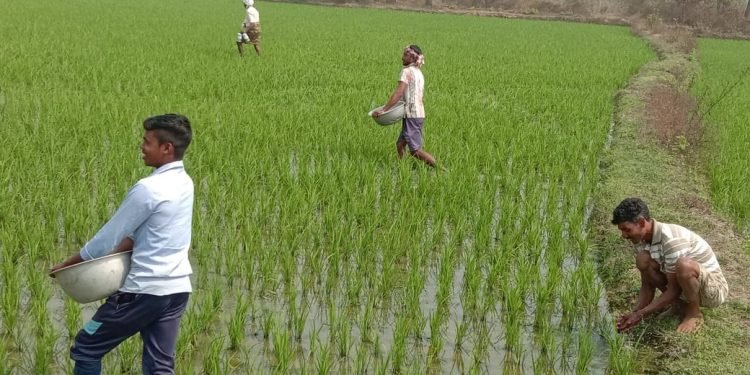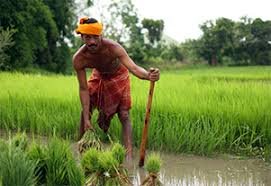by Aswini Kumar Darjee
Bargarh, often hailed as the “rice bowl” of Odisha, is once again facing a crisis during its peak agricultural season. Despite its vast and fertile lands where over 80% of the population depends on farming, farmers here continue to battle not just the whims of nature but the failures of system and supply.
This year’s Kharif season began with hope, as paddy transplantation and sowing picked up momentum across villages in blocks like Padampur, Bhatli, Ambabhona, and Bargarh. However, that optimism is quickly withering under the scorching pressure of a fertilizer shortage that has left farmers desperate and angry.
In areas where DAP and urea are essential during the early stages of crop growth, farmers allege that supplies at Primary Agriculture Cooperative Societies (PACS) and licensed retailers are either insufficient or unavailable. In their absence, the black market is thriving, turning the already tight margins of agriculture into a survival test.
Suresh Nekanti, a farmer leader from Kalapani village in Bargarh block, did not mince words. “When the sowing season begins, we need DAP and urea the most. But go to any PACS centre, and you’ll find empty godowns. Meanwhile, private dealers are hoarding and selling it at inflated prices. The Agriculture Department remains a silent spectator. This is not negligence, it’s betrayal.”

In the ongoing Kharif season, agricultural operations in Bargarh district are targeted to cover 3,42,230 hectares of land. As per this plan, the fertilizer requirements include 33,800 metric tonnes of urea, 17,000 MT of DAP, 4,000 MT of MOP, 500 MT of SSP, 11,000 MT of complex (20-20-0-13), 8,950 MT of complex (28-28-0), 5 MT of complex (10-26-26), 1,325 MT of complex (16-16-16), and 20 MT of complex (14-35-14) for use across various crops.
Despite adequate allocation of urea and DAP fertilizers to Bargarh, farmers allege that profiteering traders are exploiting the situation. According to the government-fixed price, Farmers report that a 45 kg bag of urea, which is officially priced at Rs266.50, is being sold for as high as Rs350 in the black market. Similarly, DAP bags meant to be sold at Rs1350 are reportedly being sold between Rs1550 and Rs1600. Worse still, some farmers are being forced to buy nano urea bottles they don’t want — just to be allowed to purchase regular fertilizers.
“It’s a cruel joke,” says Har Bania, district secretary of Jai Kisan Andolan. “When we sell our paddy, we don’t get the Minimum Support Price declared by the government. But when we go to buy fertilizers, we are forced to pay more than the government-fixed rates. Farmers are being squeezed from both ends. And yet, our local leaders and ministers look the other way.”
The frustration is mounting as crop schedules are thrown off and plants wither due to lack of nutrients. Farmers fear the yield will be drastically affected if the issue is not resolved within the next two weeks. With a gross cropped area of nearly 5 lakh hectares and irrigation covering 72% of it, the scale of damage can have far-reaching economic consequences for the district and the state.
What adds to the fury is the lack of accountability. While the Agriculture Department claims no official complaints have reached them, farmers insist they have raised the issue multiple times, only to be met with silence or inaction. District Agriculture Officer Lochan Chandra Majhi maintains that no complaints of black marketing have been received, but assures that strict action will be taken if any are brought to his attention.
The problem, however, is not just limited to this season. Farmers point out that Bargarh’s agriculture sector continues to face systemic neglect despite being a major contributor to the state’s food production. Pulse cultivation in rainfed areas like Padampur is showing promise, yet support remains inconsistent. Potato procurement failed due to poor planning, and fertilizer planning is now proving to be just as faulty.
“There’s no shortage of targets or schemes on paper,” says Nekanti. “What’s missing is sincerity in implementation. Every year, the same issues repeat. This is not a seasonal crisis — it’s a chronic policy failure.”
As the government pushes for modernized agriculture with mechanization, scientific pest control, and better post-harvest management, farmers on the ground continue to demand the basics — timely fertilizer supply, fair pricing, and protection from exploitation.
Without urgent action, Bargarh’s farmers fear this season could yield not just poor harvests, but deeper disillusionment — one more step away from the promise of a secure and dignified agricultural livelihood.






